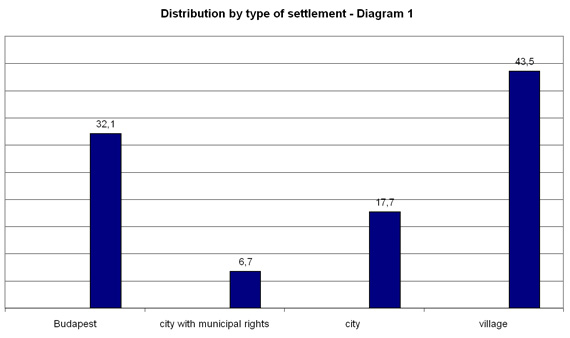Distribution of the Survivors by Type of Settlement
We have grouped the settlements into four categories: the capital (Budapest); cities with municipal rights (törvényhatósági jogú város);[1] cities with other statuses; and "village" (község), which is a collective term for all settlements that do not fall into the first three categories.

The diagram clearly shows that the body of documents is dominated by testimonies given by survivors from villages.
This result is correlative with the fact that was already mentioned in the case of the regions: almost half of those answering the questions of the DEGOB employees were from Carpatho-Ruthenia, i.e., a region which is less urbanized than average in the country.[2]
The other remarkable result of the analysis is the significant proportion of the inhabitants of the capital, which exceeds the proportion of the 1941 census on a considerable scale.[3]
To sum up, we may point out that the DEGOB collection contains predominantly the testimonies of those living in the villages (43.5 percent), and in the second place, those from the capital (32.1 percent). The proportion of those from the cities of the countryside does not reach 25 percent.
Distribution of gender by type of settlement
Distribution of age groups by type of settlement
Distribution of age of men by type of settlement
Distribution of age of women by type of settlement
Footnotes
[1] There were 21 cities with municipal rights in 1944: Baja, Budapest, Debrecen, Győr, Hódmezővásárhely, Kassa, Kecskemét, Kolozsvár, Komárom, Marosvásárhely, Miskolc, Nagyvárad, Pécs, Sopron, Szabadka, Szatmárnémeti, Szeged, Székesfehérvár, Újvidék, Ungvár, Zombor.
[2] Besides Ungvár, which was a city with municipal rights, only Munkács and Beregszász were officially cities.
[3] Approximately 22 percent of the ca. 825,000 Jews of Hungary lived in the capital.

